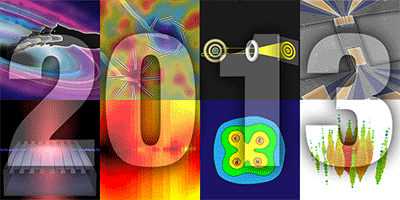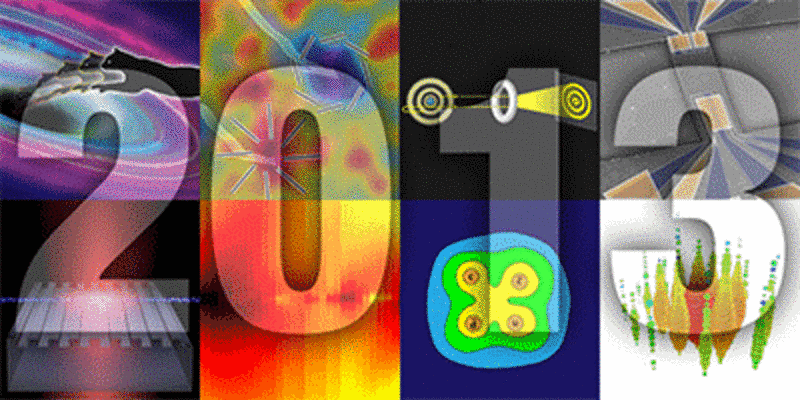Highlights of the Year
As 2013 draws to a close, we look back on the research covered in Physics that really made waves in and beyond the physics community. In thinking about which stories to highlight, we considered a combination of factors: popularity on the website, a clear element of surprise or discovery, or signs that the work could lead to better technology. On behalf of the Physics staff, we wish everyone an excellent New Year.
– Matteo Rini and Jessica Thomas
Four-Quark Matter
Quarks come in twos and threes—or so nearly every experiment has told us. This summer, the BESIII Collaboration in China and the Belle Collaboration in Japan reported they had sorted through the debris of high-energy electron-positron collisions and seen a mysterious particle that appeared to contain four quarks. Though other explanations for the nature of the particle, dubbed Zc(3900), are possible, the “tetraquark” interpretation may be gaining traction: BESIII has since seen a series of other particles that appear to contain four quarks.
Strangers from Beyond our Solar System
Detector experiments hunting for rare events can go years and never see anything out of the ordinary. So it was cause for excitement when IceCube, a giant neutrino telescope at the South Pole, reported the detection of two neutrinos with energies of around 1000 tera-electron-volts (TeV), roughly a billion times more energetic than those arriving from the Sun. Scientists at IceCube have since further analyzed their data and reported 26 more neutrinos with energies above 30 TeV. Researchers will need to observe many more of the neutrinos before they can be certain of their source, and that may require a larger detector. But they believe the particles were produced outside of the Solar System (experiments haven’t detected neutrinos from so far away since 1987) and may be carrying information about astrophysical events, like gamma-ray bursts, in distant galaxies.
Dark Matter is Still Obscure
2013 was an eventful year in dark-matter research, with leading search efforts releasing long-awaited results—though the puzzle of what makes up the dark matter remains unsolved. In April, the collaboration running the Alpha Magnetic Spectrometer aboard the International Space Station reported the observation of an excess of positrons in the cosmic ray flux. This could well originate from the annihilation of dark-matter particles in space, but data at higher energies are needed to rule out other explanations. Two other Earth-bound experiments instead attempted to capture candidate dark-matter particles called WIMPs as they pass through Earth. The Cryogenic Dark Matter Search (CDMS) experiment at the Soudan Mine in Minnesota caused a stir when it announced it had detected a few blips in its cryogenic detectors that could potentially be assigned to WIMPs. But the excitement was soon dampened by the Large Underground Xenon (LUX) experiment in South Dakota. LUX, with nominally much better sensitivity, saw no evidence of such dark-matter particles. Both experiments are now racing to improve their sensitivities and hoping to deliver unequivocal dark-matter signals.
Light Stopped for One Minute
Light travels at 1 billion km/hour in vacuum, but physicists know how to engineer materials that can bring it to a complete halt—an effect that could be used in quantum computing to store information carried by photons. A team at the Technical University of Darmstadt, Germany, managed to stop a beam of light for a record-breaking full minute. The method exploits a phenomenon called electromagnetically induced transparency, in which a control laser can make an opaque medium temporarily transparent and thus able to store light. While one minute is approximately the theoretical limit achievable in the particular crystal the team used, much longer storage times may be in sight: The researchers are now tuning their experiments to work with europium-doped crystals, which theoretically allow storage times of several hours.
Telescope Detects Twist in Ancient Cosmic Light
The cosmic microwave background (CMB)—the “afterglow” of the big bang—is our best source of information on the infant Universe. While researchers race to interpret the all-sky CMB map released in March 2013 by the Planck satellite, one of the year’s highlights in cosmology came from a terrestrial observation: A collaboration running the South Pole Telescope made the first detection of a subtle distortion in the CMB radiation known as B-mode polarization. The observed twisting occurs because the CMB light rays experience gravitational lensing as they encounter lumps of matter en route through the Universe to us. The achievement could lead to a map of the distribution of matter in the Universe, including the elusive dark matter.
Lasers of Sound
Sound waves and light have much in common, and many concepts from optics, from invisibility cloaks to lasers, have influenced acoustics. In March 2013, a research team at NTT Basic Research Laboratories, Japan, demonstrated the first entirely acoustic analog of a laser. The researchers used a “nanodrum” to excite acoustic vibrations (phonons), which they then amplified through stimulated emission to deliver spectrally pure sound waves with a frequency of around 1.7 megahertz. When the team reported their work in March, they weren’t yet able to extract waves from the device. But recently, the group has demonstrated phonon waveguides that, in analogy to optical fibers, could be coupled to the phonon laser to transfer and use the generated acoustic waves. Phonon lasers might one day deliver directional and coherent sound beams, which could be used for imaging or communication applications.
Microscope Spies on Hydrogen
Open any first-year quantum mechanics book and you’ll probably find a sketch of hydrogen’s spherical, dumbbell, and clover-shaped electron orbitals. But until this year, researchers couldn’t claim to have actually observed these electron clouds experimentally. To take a peek, researchers at the FOM Institute for Atomic and Molecular Physics, Netherlands, and collaborators designed a “quantum microscope” that ionized hydrogen atoms with light and then used an electrostatic lens to create an interference pattern of the escaping electrons. The researchers used the interference image to reconstruct the original electron orbitals.
Facilities in a Box
This year, scientists found new ways to offer some of the capabilities of large and expensive facilities in setups that could be housed in individual labs. With equipment that should ultimately fit onto a tabletop, researchers at Los Alamos National Laboratory, New Mexico, produced a beam of neutrons intense and focused enough to image defects in materials. Possible applications of the mini neutron source, which uses the interaction between a powerful laser and a solid target to generate the neutrons, include testing neutron sensors and analyzing the effects of radiation damage on materials. In a similar effort, two teams, one led by researchers at Stanford University, California, and the other a collaboration between researchers at the Max Planck Institute of Quantum Optics and Friedrich Alexander University Erlangen-Nuremberg, both in Germany, presented an important step toward making cheaper and more compact x-ray sources. The two teams showed they could accelerate electrons with nanoscale optical gratings that are much smaller than the radio-frequency technology used at particle accelerators. In future work, the teams want to show the devices can generate higher fields and a greater flux of electrons.
Majorana Fermions Annihilate in Nanowires
Physicists have long been searching for signs of Majorana fermions, which are neutral fermions that are their own antiparticles. Evidence for a fundamental particle that is also a Majorana fermion is inconclusive (see 19 September 2013 Synopsis), but condensed matter physicists have shown early evidence that collective states (quasiparticles) in certain superconducting devices can have an analogous behavior. This year, researchers at the University of Illinois at Urbana-Champaign generated two of the quasiparticles at either end of a nanowire connected to superconducting leads and then used a magnetic field to cause the states to annihilate, as expected when a particle meets its antiparticle. Finding examples of Majorana states in solids could be a route to making quantum computers that are more resistant to noise.
A Year of Quantum Victories—But No Quantum Computer Yet
Do we have quantum computers, and are they better than conventional ones? The Canadian company D-Wave Systems reported that they had successfully tackled a hard-to-solve problem on their putative quantum computer. But many scientists would argue there is no evidence that the device, made of ∼100 superconducting elements, can be called a quantum computer or that it outperforms classical computers. While quantum computing may still be some years in the future, in 2013 researchers reported a number of victories against obstacles to quantum information and communication protocols. In quantum cryptography, code makers regained the upper hand against code breakers, when two independent research teams demonstrated a new encryption method that may provide the ultimate security against hackers. Two other reports showed how entanglement, the essential ingredient that gives quantum technologies an advantage over classical methods, can be protected from noise and dissipation. A team at the Massachusetts Institute of Technology, Cambridge, showed that in a secure quantum communication channel, the benefits of entanglement can be harnessed even after its breakup induced by noise. And researchers at the Free University of Berlin, Germany, the Niels Bohr Institute, Denmark, and the Technical University of Munich, Germany, suggested that, thanks to a technique called quantum illumination, dissipative processes can be put to use to engineer more robust quantum states.
What’s Inside a Black hole?
In 2012, a group of physicists at the University of California, Santa Barbara, proposed that an observer falling into a black hole would be destroyed by a firewall at the event horizon. If such a firewall existed, they argued, it would solve certain inconsistencies in black hole theory, but the idea sparked a heated debate among theoretical physicists: firewalls violate Einstein’s well-established equivalence principle, which says that an observer can’t distinguish between inertial motion and free fall and therefore shouldn’t be able to tell if he has passed the event horizon. This year, two of the original firewall proponents, have rekindled the debate. The authors developed a theoretical model to describe the interior of the black hole, suggesting an in-falling observer would encounter a sea of quanta of arbitrarily high energy, i.e., a “wall of fire.”
Correction (6 January 2014): Because of an editing error, the speed of light in “Light Stopped for One Minute” was written incorrectly.
Correction (7 January 2014): The location of the CDMS experiment in “Dark Matter is Still Obscure” was incorrect.





